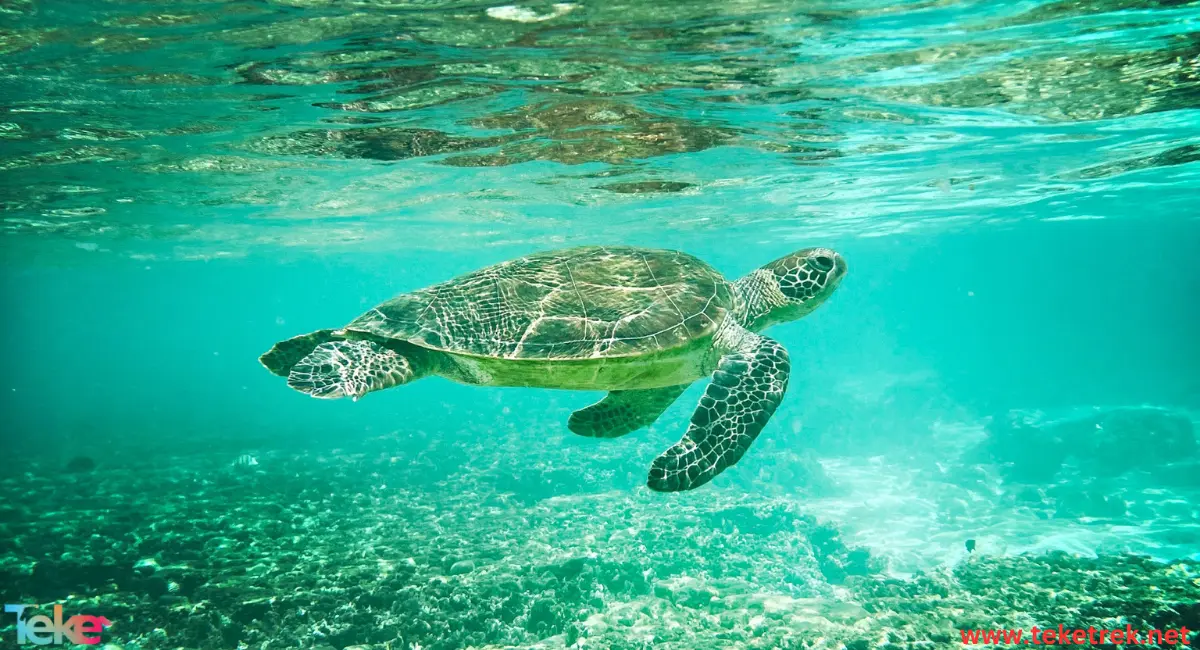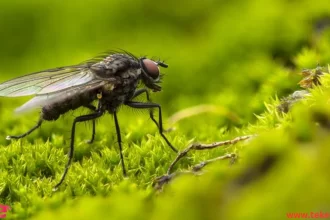The green sea turtle is one of the largest species of sea turtles with a hard shell. It is unique among sea turtles because it is an herbivore, feeding on marine grasses and algae.
This diet is what gives it the green color, hence its name.
Let’s explore more about these animal from teketrek.

External appearance of the green turtles:
Green turtles are characterized by being the largest among all sea turtles with hard shells.
The green sea turtle belongs to the class Reptilia, order Testudines.
They have relatively small heads.
Adult green turtles can reach about 1 meter in length and weigh from 130 to 160 kilograms.
Green turtles have dark brown, gray, or olive-colored shells.
They have a ventral side characterized by its light yellow or white color.
It also has a serrated beak on the lower jaws and large scales between the eyes.
Locations of Green Sea Turtles:
Green sea turtles are found in tropical and subtropical oceans worldwide, especially in the Atlantic Ocean. They extend north to Canada and Britain, and south to the tip of South America and South Africa.
What do Green Sea Turtles Eat?
Green sea turtles are herbivores, feeding on marine grasses and algae. They are the only herbivorous species among sea turtles. Their diet primarily consists of algae and marine grasses, although they may also feed on sponges, invertebrates, and discarded fish. Green turtles in the Eastern Pacific tend to consume more animal prey compared to other sea turtle species. They dive underwater to feed on algae and marine grasses. When they surface, they expel the air used in their lungs and replace it with fresh air within seconds. Their unique oxygen distribution system allows them to withstand the pressure of deep water without suffering from the effects of gas bubbles.
General Behavior and Lifestyle of Green Sea Turtles:
Like all sea turtles, green sea turtles are reptiles and must surface to breathe and lay their eggs on land.
Green sea turtles migrate hundreds to thousands of kilometers in all directions between their feeding areas and nesting beaches. They are solitary and nocturnal creatures.
The life history of green sea turtles includes a series of developmental stages from hatching to adulthood.
After hatching, the hatchlings swim to marine habitats, where they live for several years in their surface habitat.
The young leave the open ocean habitat for near-shore areas in shallow coastal habitats in search of food.There, they mature into adulthood and spend the rest of their lives.
Adult turtles migrate every two to five years from foraging areas near the coast to waters off nesting beaches, where they originally hatched, to breed.
Reproduction in Green Sea Turtles:
Green sea turtles may reach up to 50 years of age before becoming sexually mature.
Typically, green sea turtles undertake long migrations from their feeding grounds to their nesting areas. They return to mate in the same nesting areas where they were hatched.
Females mate every two to four years, while males mate annually.
The timing of mating depends on the specific location of the turtles. For example, turtles in tropical regions (the warmest areas) may mate year-round, while other populations in colder climates will mate from March to June.
Females control the mating process in all populations, granting permission to males.
Mating occurs in the water once fertilization takes place. The female climbs ashore past the high tide line and digs a hole to lay her eggs, typically depositing between 100 to 200 eggs before returning to the water. Females may mate again and create another nest. Some females may create up to 5 nests during one mating season.
The sex of the hatchlings is somewhat determined by the temperature of the surrounding sand. Lower temperatures produce more males, while higher temperatures produce more females.
After a period of two to five months, the eggs hatch, and the hatchlings instinctively make their way to the water.
Hatchlings that successfully evade predators will spend 3 to 5 years in the open ocean before settling into a nearshore lifestyle.
How long do green sea turtles live?
Green sea turtles can live up to an average of 80 years in the wild.
Threats to Green Sea Turtles:
Green sea turtles have been exploited for their fat, meat, and eggs, leading to a decline in their numbers.
Some countries, such as the United States, prohibit the killing of sea turtles or the collection of their eggs. However, in some areas, the killing of green sea turtles for their meat or shells still poses a threat to their existence.
The biggest threats facing green sea turtles include commercial and recreational fishing, ship strikes, habitat loss, and climate change.
What is the swimming speed of green sea turtles?
Green sea turtles swim at an average speed of about 1.5 kilometers per hour. Their speed can increase to about 30 kilometers per hour when escaping predators.

FAQ
- What do green sea turtles eat?
Green sea turtles are herbivores, primarily feeding on marine grasses and algae.
- Why are green sea turtles endangered?
Green sea turtles are endangered due to loss of habitat, illegal fishing, environmental pollution, climate change, and illegal trade in their products.
- How long do green sea turtles live?
Green sea turtles can live up to an average of 80 years in the wild.
- Why are green sea turtles special?
Green sea turtles are special because they are ancient creatures with a unique diet, long lifespan, remarkable migration patterns, ecological importance in marine ecosystems, cultural significance, and are the focus of global conservation efforts.
- How many green sea turtles are left?
The population of green sea turtles has been declining over the years due to various threats such as habitat loss, pollution, and hunting. However, there isn’t a precise number that indicates how many green sea turtles are left in the world.
- Are green sea turtle the world’s largest?
Green sea turtles are not the world’s largest turtles. While they can grow to impressive sizes, with adults typically weighing between 90 to 227 kilograms and measuring about 1 to 1.2 meters in carapace length, there are other species of turtles that are larger.
In conclusion, green sea turtles remain fascinating creatures. They represent an important indicator of biodiversity and the preservation of marine environments. Green sea turtles are a vital part of the ocean ecosystem, and it’s our duty to conserve them and their natural habitats. We must enhance our efforts to protect these amazing beings and ensure their continuity for future generations.





